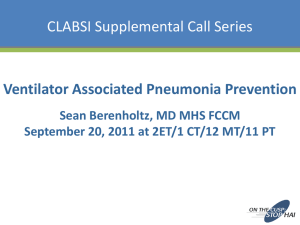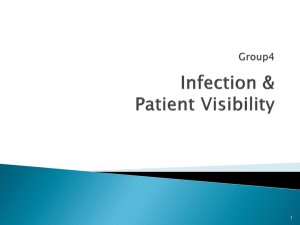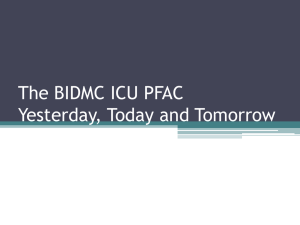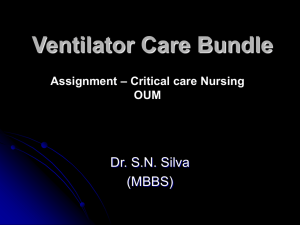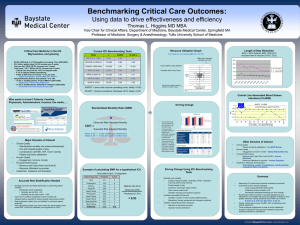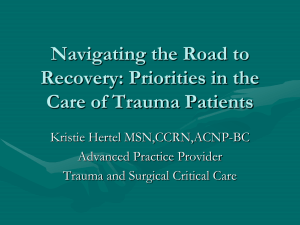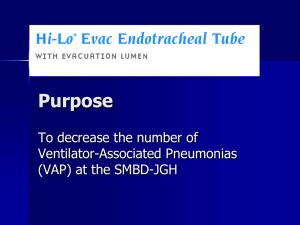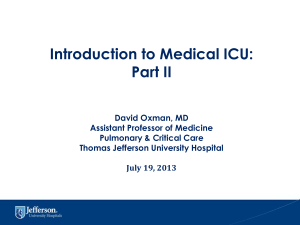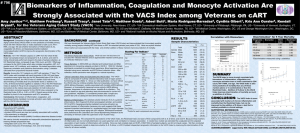streamlined versus conventional vap surveillance
advertisement
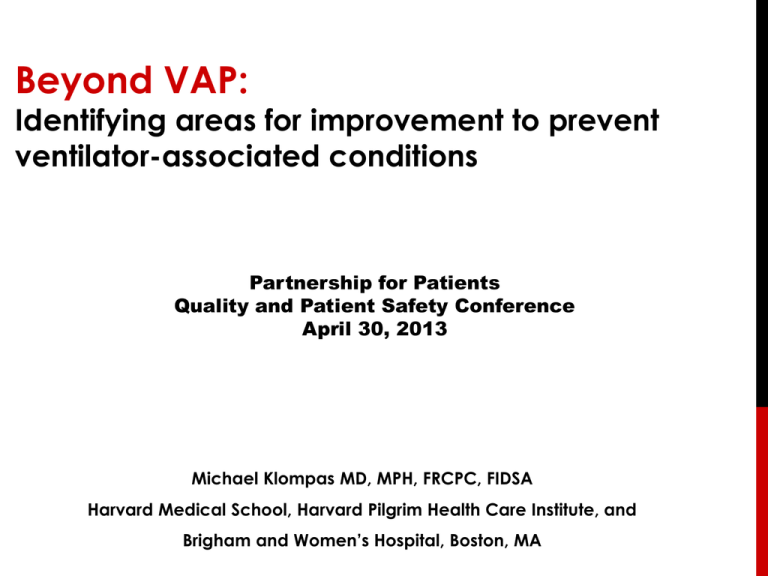
Beyond VAP: Identifying areas for improvement to prevent ventilator-associated conditions Partnership for Patients Quality and Patient Safety Conference April 30, 2013 Michael Klompas MD, MPH, FRCPC, FIDSA Harvard Medical School, Harvard Pilgrim Health Care Institute, and Brigham and Women’s Hospital, Boston, MA Disclosures Honoraria from Premier Healthcare Alliance Outline 1. Ventilator-associated events – a patient safety opportunity 2. Zero VAC – where do we start? 3. The problem with current ventilator bundles 4. The promise of better weaning & sedation strategies 5. The CDC Prevention Epicenters’ Wake Up & Breathe Collaborative 6. Lessons learned Ventilator-associated events • VAP – subjective, inaccurate, and rare • VAC – simple and objective – seeks all complications of mechanical ventilation, not just pneumonia. • Most cases due to: • • • • Pneumonia Pulmonary edema ARDS Atelectasis • VAC is a strong predictor of poor outcomes (increased ventilator days, hospital days, and mortality) Ventilator-associated event surveillance A patient safety opportunity Increase Awareness • VAC surveillance provides hospitals with a fuller picture of complications in mechanically ventilated patients Catalyze Prevention • A significant portion of VACs are likely preventable Reflect and Inform Progress • VAC surveillance provides an efficient and objective yardstick to track one’s progress relative to oneself and to peers Where do we start? Image from http://img.ehowcdn.com/article-new/ehow/images/a07/86/tp/increase-torque-cars-rear-end-800x800.jpg VAP Prevention Measures Impact on VAP Rates 78% Head-of-bed elevation Regular oral care with chlorhexidine 40-60% Daily interruption of sedation 64% Daily assessment of readiness to extubate 10% Continuous aspiration subglottic secretions 37-75% Silver coated endotracheal tubes 36% Am J Respir Crit Care Med 2006;174:894 Lancet 1999;354:1851 BMJ 2007;334:889 JAMA 2008;300:805 NEJM 2000;342:1471 Crit Care Med 2004;32:1272 Chest 2000;118:459 Ann Intern Med 1995;122:179 But VAP diagnoses are unreliable. Can we trust the VAP reduction rates reported in the literature? Silver Coated Endotracheal Tubes VAP Rates and Outcomes 6.0 12.0 5.0 10.0 4.0 8.0 3.0 6.0 2.0 4.0 1.0 2.0 0 VAP Incidence Vent days ICU days Hospital days 0 JAMA 2008;300:805-813 Silver coated ETTs Lengths of Stay (days) VAPs per 100 Patients Conventional ETTs Oral antiseptics & outcomes VAP Vent days ICU days Mortality Antiseptics protective Antiseptics harmful Chan et al., BMJ 2007;334:889 The VAP Prevention Paradox VAP Rates Vent LOS ICU LOS Hospital LOS Death Head-of-bed elevation Regular oral care with chlorhexidine Silver-coated endotracheal tubes Klompas, Critical Care 2009;13:315 Why the Paradox? VAP as measured includes a multitude of conditions, ranging from benign to serious Less serious: bacterial colonization superimposed upon atelectasis / CHF / barotrauma More Serious: pneumonia, ARDS, pulmonary infarction, others Most prevention measures work by decreasing oral secretions or bacterial colonization Circularity between mechanism of action and diagnostic criteria Preferential impact on less serious events leading to lower perceived VAP rates, smaller impact on more serious events For any given intervention, difficult to know if primary impact is on less serious or more serious events since both count as “VAPs” Klompas, Critical Care 2009;13:315 What does work? Vent LOS Sedative interruption Readiness to extubate Sedative interruption AND Readiness to extubate ICU LOS Hospital LOS Mortality Daily Interruption of Sedation * 10.0 8.0 Days Daily interruption Usual Care NS * 5 4 3 6.0 4.0 2 2.0 Cases of VAP N=128 1 0 0 Duration of Ventilation ICU Stay VAP Cases Kress, NEJM 2000:342:1471 Schweickert, Crit Care Med 2004;32:1272 Daily Interruption of Sedation & Daily Spontaneous Breathing Trials Daily sedative interruption AND spontaneous breathing trial N=168 Outcome Daily spontaneous breathing trial alone N=168 Impact P Time on Ventilator 3.1 days .02 ICU Length of Stay 3.8 days .01 Hospital Length of Stay 4.3 days .04 Mortality at 1 year 32% .01 Girard, Lancet 2008;371:126 Slide courtesy of Wes Ely One year survival 100 Patients Alive (%) 80 60 SAT+SBT (n=167) 40 Usual Care+SBT (n=168) 20 p=.01 0 0 60 120 180 Days 240 300 360 Girard TD, et al. Lancet 2008;371:126-34 Improving Sedation Management A good strategy to prevent VACs? Sedation and prolonged mechanical ventilation are both important risk factors for multiple complications of intensive care • • • • • • Pneumonia ARDS Pneumothorax Pulmonary edema Delirium Kidney dysfunction • GI bleeding • Bacteremia • Thromboembolic disease • Cholestasis • Sinusitis Sedative interruption adherence poor • Daily sedative interruptions are a component of most ventilator bundles but audits suggest that in practice interruptions are only done about 25-50% of the time • e.g. Brigham and Women’s Hospital, Boston, 2011 • Sedative interruption 54% of sedative-days • Contraindication marked 31% of sedative-days • List of contraindications liberal • Included “high ventilator requirements” (40%), “weaning from high sedative dose” (16%), and “hemodynamic instability” (22%) Klompas, Unpublished Data Are we unduly cautious with sedative interruptions? • 140 patients randomized to routine sedation versus no sedation • • • • 70 prescribed routine sedation (propofol then midazolam) 70 prescribed no sedation Morphine boluses permitted for both groups PRN Unblinded • Patients with no sedation • • • • Mean 4.2 (95% CI 0.3-8.1) fewer days on the vent Shorter ICU stay (HR 1.86, 95% CI 1.1-3.2) Shorter hospital stay (HR 3.6, 95% CI 1.5-9.1) More agitated delirium (20% versus 7%) but no difference in self-extubations Strøm et al. Lancet 2010;375:475 The CDC Prevention Epicenters’ Wake Up and Breathe Collaborative The CDC Prevention Epicenters’ Wake Up and Breathe Collaborative 13 ICUs from 8 hospitals Stroger Cook County Hospital Missouri Baptist Medical Center Duke University Durham VA Durham Regional Hospital North Shore Union North Shore Salem Hospital of the University of Pennsylvania Goal: prevent ventilator associated complications through less sedation and earlier liberation from mechanical ventilation Mechanism: paired daily spontaneous awakening trials and breathing trials (SATs and SBTs) Collaborative Components All Teach – All Learn Model Each participating unit has designated RN, RT, and MD champions Monthly written reports by each ICU – Progress, challenges, successes, and failures from the preceding month Goals for the forthcoming month Monthly collaborative phone calls for all champions Monthly data feedback and benchmarking Collaborative facilitated by a CDC “improvement advisor” Two in-person meetings at CDC for all champions held April 2012 (kick-off) and October 2012 (consolidation) Expert advice from CDC, Institute for Healthcare Improvement, and consulting faculty Lessons Learned 1. Get the right people on the bus 2. Educate, educate, and re-educate 3. The spirit of the law matters more than the letter of the law 4. Assess performance not just documentation 5. It’s a marathon not a sprint 6. Choose the denominator that fits the intervention 7. Wake up and walk Get the right people on the bus Chief Quality Officer Chief Nursing RT Champion Officer Frontline RTs ICU Medical Director Night Staff Day Staff Local Opinion Leaders Pharmacists Frontline Nurses MD Champion ICU Nursing Director Chief Medical Officer RN Champion Head of Respiratory Therapy Frontline Doctors Unit Clerk Image from http://www.kerrvilleisd.net/files/bus_cartoon_tilt.gif Educate, educate, & re-educate Never assume that everyone knows about the protocol Never assume that everyone understands the protocol Never assume everyone agrees with the protocol Use both formal and informal teaching methods • In-services, postings, articles, lectures • Ask colleagues for their impressions, seek hallway discussions, bring it up at morning rounds The Spirit of the Law Matters More than the Letter of the Law Our goal is not to perform SATs per se but to minimize the use of sedatives and speed extubation SATs and SBTs are a means, not an end “Conclusion: For mechanically ventilated adults managed with protocolized sedation, the addition of daily sedation interruption did not reduce the duration of mechanical ventilation or ICU stay.” Mehta et al. JAMA 2012;308(19):1985-92 Midazolam Equivalents Total Midazolam (mg) per Patient Control SAT 20000 18000 16000 14000 12000 10000 8000 6000 4000 2000 0 Kress 2000 Girard 2008 Mehta 2012 Fentanyl Equivalents Total Fentanyl (mg) per Patient Control SAT 20000 18000 16000 14000 12000 10000 8000 6000 4000 2000 0 Kress 2000 Girard 2008 Mehta 2012 Boluses Per Day in Mehta et al. Control SAT 2.5 2 1.5 1 0.5 0 Midazolam Fentanyl Assess Performance as well as Documentation 100% 80% 60% 40% SATs (performed/indicated) 20% 0% Feb Mar Apr May Jun Jul Aug Sep Assess Performance as well as Documentation 100% 80% 60% 40% SATs (performed/indicated) 20% SATs (performed/sedative days) 0% Feb Mar Apr May Jun Jul Aug Sep It’s a marathon not a sprint Image from http://media.mediapost.com/images/inline_image/2012/01/27/Boston-Marathon-B.jpg SAT Performance, ICU X, June 2012 – March 2013 100% 80% 60% 40% 20% 0% Jun Jul Aug Sep Oct Nov Dec Jan Feb Mar SAT Performance, ICU Y, June 2012 – March 2013 100% 80% 60% 40% 20% 0% Jun Jul Aug Sep Oct Nov Dec Jan Feb Mar Chose a denominator that fits the intervention • The traditional metric for hospital-acquired infections is infections per 1000 device-days or patient days • What if your intervention, however, is specifically designed to reduce device days? Absolute Counts: VACs Number of VACs per Month 14 12 10 8 6 VACs 4 2 0 Jun Jul Aug Sep Oct Nov Dec Jan Feb Mar Absolute Counts: VACs and Vent Days 1000 900 12 800 10 700 600 8 500 6 400 VACs Vent Days 4 300 200 2 100 0 0 Jun Jul Aug Sep Oct Nov Dec Jan Feb Mar Number of Ventilator Days per Month Number of VACs per Month 14 VACs per 1000 Ventilator Days VACs per 1000 Ventilator Days 14 12 10 8 6 VACs per 1000 vent days 4 2 0 Jun Jul Aug Sep Oct Nov Dec Jan Feb Mar VACs per 1000 Ventilator Days vs VACs per 100 Episodes of Mechanical Ventilation VACs per 1000 Ventilator Days 14 12 10 8 6 VACs per 1000 Vent Days 4 VACs per 100 Episodes 2 0 Jun Jul Aug Sep Oct Nov Dec Jan Feb Mar Early mobility – Wake Up & Walk! Increasing evidence that early mobilization speeds extubation and decreases ICU length of stay May also help prevent atelectasis & delirium As with improved sedative management and weaning protocols, less time on vent means less time at risk for VACs http://69.36.35.38/images/CHESTPhysician/Crit CareCom0610Fig2.jpg Lord et al., Crit Care Med 2013;41:717 Schweickert et al., Lancet 2009;373:1874 Needham et al., Arch Phys Med Rehabil 2010;91:536 Summary VAE surveillance is a patient safety opportunity Spontaneous awakening trials and spontaneous breathing trials decrease ventilator days, hospital days, and mortality. • Maybe SATs and SBTs can also lower VAC rates! Lessons learned from the CDC Prevention Epicenters’ Wake Up and Breathe Collaborative: • • • • • • • Get the right people on the bus Educate, educate, and re-educate The spirit of the law matters more than the letter of the law Assess performance as well as documentation It’s a marathon not a sprint Choose a denominator that fits the intervention Wake up and walk! Thank You! Michael Klompas (mklompas@partners.org)
